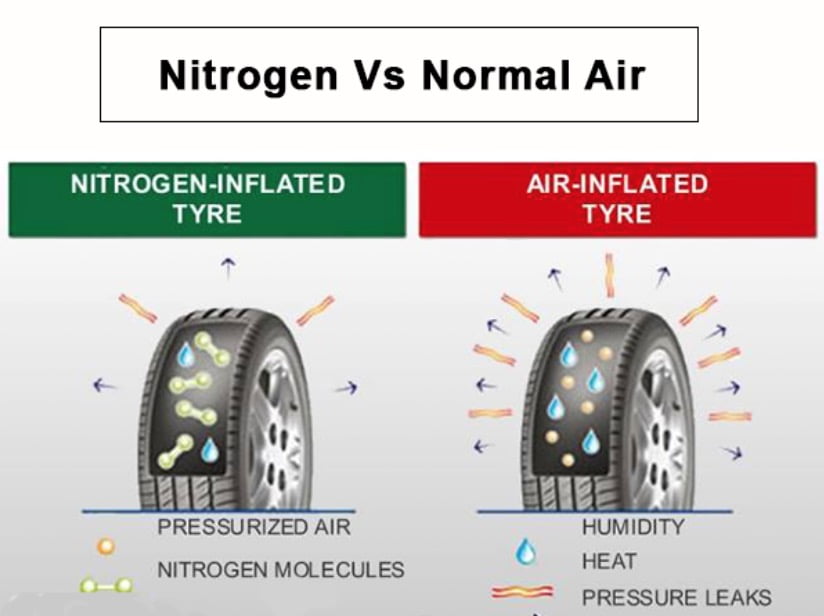In this article, we shall discuss the advantages and disadvantages of Nitrogen and Air-filled tyres. You must have seen the nitrogen pumps at the gas stations. In fact, a lot of people have adopted the use of nitrogen gas in their tyres. Let us find out if there are some benefits to that or not. Also, we will discuss, in detail, the myths related to filling nitrogen gas in your tyres. So without any further ado, let us get into this.
Also read: Have You Been Driving Manual Transmission Wrong All This While?

Nitrogen vs Air in Tires
The only difference between the two is the proportion of gases used to fill up your tyres. In the case of air, 78% of it is Nitrogen, 21% Oxygen and 1% other gases. In the case of Nitrogen, there is almost no other gas except for Nitrogen. In a way, you are filling up your tyres with pure Nitrogen. There are few reasons why that might be a good idea.
Also read: ClearMotion Suspension Technology – Working & Advantages!
Advantages
The biggest advantage of having a Nitrogen-filled tyre is the absence of water vapour molecules. What this essentially translates to is the lack of water or moisture inside the tyre. The significance of it is the fact that the tyre pressure becomes less susceptible to changes in temperature. This is the biggest advantage of having Nitrogen in your tyres compared to air. This could be a huge difference if you are driving in summer in our country. The temperatures can be very high in most parts of the country. We must have seen in the news that there are incidents of tyre bursting. This happens because the water vapour expands due to heat and causes the tyre pressure to rise. This will happen with Nitrogen to an almost negligible extent because Nitrogen is devoid of moisture.
Also read: Working Of A Carburettor Using A Transparent Unit!
Secondly, if you have your vehicle parked for a long duration, there are chances that the air molecules will escape over time and the pressure in your tyre will reduce automatically. This requires a regular top-up of air. Nitrogen molecules, being larger in size than oxygen molecules, do not escape so easily and your tyres will remain at almost a constant pressure for longer periods. However, the difference in the size of the Nitrogen and Oxygen molecules is not that significant.
Also read: Types Of Chassis Frames – Monocoque, Ladder Frame, Backbone and Tabular!
Disadvantages
The main disadvantage of Nitrogen filled tyres could very well be the cost. It might be free after the first time (or not) but it still will cost you something. Compare this to the regular air, you will not have to pay anything to get the air filled in your tyres. The second issue is that of the availability. Not all petrol pumps have the option of Nitrogen, which is really the biggest challenge when it comes to using Nitrogen-filled tyres. This could discourage some people to use these tyres. Lastly, most of the claims that Nitrogen tyres promise are almost insignificant to everyday use. Millions of people have been using regular air in their tyres for hundreds of years without really facing any significant issue. So, there is not compelling enough reason to switch now.
Also read: What is Hydrogen Combustion Engine – Pros and Cons!
These were some of the features of Nitrogen vs Air-Filled tyres along with their advantages and disadvantages. We hope you understood the purpose of using Nitrogen in the tyres and if you want to follow more such blogs related to Automobile Technology, tune in to Car Blog India and do share your valuable feedback.
Also read: Front, Mid and Rear Engine Cars – Pros and Cons!
Image Source: Delhi Capital


